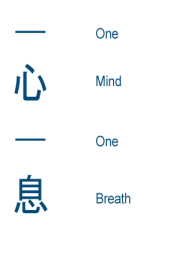The mind-breath relationship has been my interest for a long time for two reasons.
One fascinating reason is the myth of the whereabouts of the mind. For example, the Mind character in Chinese (see the graphic below) overlaps with the character for the Heart (Xin in Chinese, Sin in Japanese, Shim in Korean).
It is both confusing or comprehensive in meaning. It may mean that the mind is in the heart; that the mind and the heart are one; or that they are separate but directly connected.
In the west, we think differently. The heart is in the cavity of the chest and the mind is somewhere in the brain. Yet many believe that the heart has something to do with the mind and they are not separate. Recent studies back it up. Researchers found 'the gut brain' in the body. Some call it 'the second brain'. It functions just like the brain. Not surprisingly, it is located in the Solar Plexus, in the heart region, directly communicating with the brain via the vagus nerve, the longest nerve connecting the brain to the organs. It sends signals from the 'gut brain' to the brain.
Thinking of the gut brain, I frequently find myself basing my decisions not on the logic from the brain in my skull but 'my gut feeling’ that comes from the second brain. Through it, I can sense much more about what is not shown and told. I can feel unsung notes and unsaid sadness. It's less artificial, more direct, organic, and forceful.
Another reason for my intrigue is again linguistic. The Chinese characters of the mind and the breath share a common base character: the mind. The graphic on the right illustrates this. From the top, the characters mean One, Mind, One, Breath. Do you recognize the Mind character as the bottom part of the Breath character?
When I break down the Breath character into two pieces, I have a nose and a mind (see the graphic below left). It may mean that the nose is on top of the heart; that the nose has a heart; or that the nose is the heart in the head. My last interpretation is that breath links the nose to the heart.
What intrigues me more is the physiology of the nose. When we breathe through the nose, it triggers relaxation. It relaxes blood vessels, increases blood flow to the brain, and relaxes the entire body. Even in one breath.
Why? Because nitrogen oxide (NO) is abundant in the cavities in our nose, the walls of blood vessels relax.
How does it happen?
NO is known for vasodilation, widening blood vessels. When we breathe in through the nose, NO is activated in the nose and enters the lungs. As the blood vessels in the lungs stretch, the heart has abundant supply of fresh blood. The nose is the most powerful augmenting device for the heart. It really does its job as the nose-heart. Deep breathing through your nose is a great way to experience this.
One Mind One Breath is a small step to enlighten my heart (mind) by breath. At the base, breath rules. Grab the nose with your fingers for a moment. The heart aches. The mind panics. Take a deep breath, they share the same character of the mind. The mind that underpins and encompasses all.




